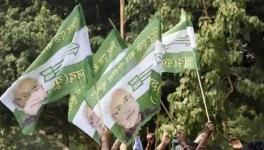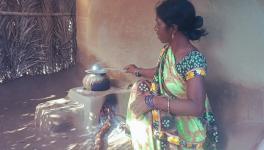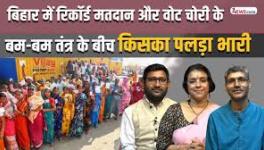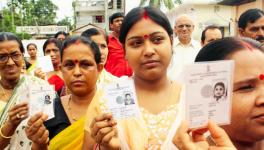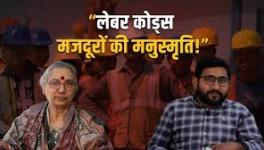How Urmila Devi Found Liberation in Mithila Painting
Darbhanga: Art can educate and create empathy, which leads to social and economic change. Urmila Devi Paswan is its one of its best living examples. A resident of Jitwarpur village in Madhubani district, known for its folk visual art form – Mithila paintings or Madhubani paintings – she is of the senior most artists who practice the Godna (Tattoo) painting tradition.
Unfamiliar with the complex imagery used by the Brahmins and Kayasthas, women from the Dusadh community (a marginalised Dalit community), encouraged by German anthropologist Erika Moser – who had visited the village between 1972 and 1978 to study and film the crafts and rituals of the scheduled caste community – began to take inspiration from their own oral, cosmological and aesthetic traditions and created their own distinctive styles and techniques — Godna (tattoo) and Tantric paintings.
These unique styles were first made famous by legendary artist Chano Devi, who brought tattoo images from people’s arms and legs to hand-made paper and canvas.
After imbibing the style from the national award winner, Urmila has been practising this art form for the past 45 years. Her works have been exhibited both nationally and internationally. She has been honoured with several awards and her works is part of folk art collections in several museums across the globe.
However, her journey, rife with social and domestic challenges, was not simple. The dominant ‘upper’ caste community allegedly tried their best to discourage her from using brushes, since they wanted a Brahmin and Kayastha monopoly over the folk art. It led to a powerful movement. As a result, a rebel genre of paintings, also called ‘Harijan paintings’, came into existence over the last few decades. Primarily done by women from Scheduled Caste communities, the Ram-Seeta, Krishna-Meera and Shiva-Parvati themes have been taken over by deities revered by the backward castes.
This style of painting was acknowledged later, with over 60 persons bagging national awards and three having won the Padma Shri since 1970.
“The transformation was not so easy. It was almost like a silent protest against the widespread discrimination the scheduled caste people and the downtrodden had to face everywhere. It helped blur the distinction between richer, better-off castes and the downtrodden,” Urmila told NewsClick.
She faced domestic violence since her husband, a toddy-addict, did not want her to paint or venture outside the four walls of her home.
“My husband used to draw a rickshaw to earn a living. We were faced with extreme poverty, and arranging two meals was difficult. With the aim to support my husband’s earning, I began practicing paintings. But he did not like it. He used to thrash me and burn my paintings in the earthen stoves at home. He did not want me to work and go outside because women stepping out were not appreciated in those days. But he could not deter me from doing something good for the family and my children. I continued practicing silently. Whatever I earned after selling the paintings, I spent it on the education of my children — two of them are now acclaimed artists,” the 70-year-old said.
“After I received the state honor in 1985-86, my husband’s attitude completely changed. He now began supporting me and respecting my work. He even accompanied me when I first stepped out of my village to go to Patna to receive the award. Since then, I have enjoyed his support. The art completely changed my life. It enabled me to impart a good education to my children and lead a respectable life in society,” she said.
Urmila’s father, Debu Paswan, was a labourer and her mother, Kaushalya Devi, was a house wife. She was married to Bilat Paswan when she was just 15.
Bilat and Urmila are landless even today. They own a small house built on government land. Their newly built two-room house has been constructed with the money they got under the Indira Awas Yojana — a housing scheme of the Central government.
Urmila is well-known in Jitwarpur. People know the way to her her house. However, what is noticeable is the that the village too has a ghetto where artists belonging to the Scheduled Caste communities live. Though her village is a hub of artists and frequented by art lovers the world over, it does not look like a settlement of artists, save for the beautiful paintings adorning the walls of most of the houses. The road leading to the village is muddy and overrun by rainwater.
The greatness of Jitwarpur lies in producing famous artists like Roudi Paswan, Chano Devi, Mahanma Devi, Dilip Paswan, Uttam Prasad Paswan, Dharmashila Devi, Maleswari Devi and Veena Devi – those who have been conferred upon with state and national awards. Unfortunately, the village does not have a museum to preserve their work for future generations.
“The late Rondi Paswan, who introduced the Godna (tattoo) style to Mithila paintings encouraged me to take up brush work. His wife, Chano Devi, taught me how to draw geometrical patterns and play with the brushes. Regular and constant practice made me learn the art form,” she said.
She said that only if the government helps artisans will the folk art form survive and touch new heights. With the village attaining fame, she said that art agents with links to the Western markets have started running the show. As a result, artists are not getting a fair price. “I urge the government to create a national-level procurement center where artists can sell their paintings themselves,” she said.
Get the latest reports & analysis with people's perspective on Protests, movements & deep analytical videos, discussions of the current affairs in your Telegram app. Subscribe to NewsClick's Telegram channel & get Real-Time updates on stories, as they get published on our website.












